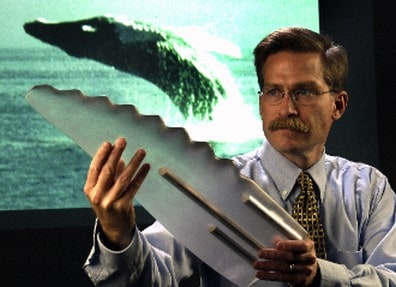Frank Fish was on vacation with his fiancée in Boston when he spotted a fine-art sculpture of a humpback whale in Quincy Market. On closer inspection, he noticed the flippers had bumps on the edges.
“I thought ‘The artist got this all wrong,'” he recalls. “But when the store manager pulled out a picture of the real deal, it had prominences, too. I was blown away.”
According to Entrepreneur, like a modern-day Ahab, Fish became obsessed with these bumps. He wanted to find out exactly how they worked in water and what their advantages were. He created dozens of mathematical models to prove how the bumps must reduce drag, suggesting a new approach to the science of fluid dynamics.
This caught the attention of Stephen Dewar, a Toronto entrepreneur, who tracked down Fish to learn more about the intriguing work. They discussed the commercial possibilities for applying flipper-inspired designs to boat keels, airplane wings and industrial turbines.
Later that year, they filed patents and leveraged roughly $500,000 from private investors to form WhalePower, based in Toronto.
Fish also determined that airfoils with this new design could operate as much as 13 percent more efficiently than those with edges that are flat. Because these bumps technically are known as “tubercles,” Fish dubbed the concept Tubercle Technology. This forms the basis of designs that WhalePower is licensing to manufacturers in the industrial fan industry.
WhalePower is negotiating licenses for its Tubercle Technology to manufacturers who incorporate fans into computers, servers, appliances and heating ventilation and air-conditioning units. “We expect to land several major customers in the next 12 months,” Dewar adds.
Photo by Canadian Manufacturing.
